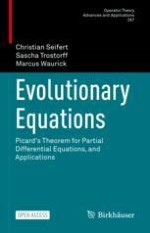13.1 Convergence of Material Laws

 . We show that T is continuously invertible first. For this, let x ∈ H. Then
. We show that T is continuously invertible first. For this, let x ∈ H. Then 13.2 A Leading Example
 , we deduce
, we deduce
 in L
2(μ). Since L
2(μ) embeds continuously into L
1(μ) we obtain V
n → V in L
1(μ).
in L
2(μ). Since L
2(μ) embeds continuously into L
1(μ) we obtain V
n → V in L
1(μ).
 where \(a=(a_{1},\ldots ,a_{d}),b=(b_{1},\ldots ,b_{d})\in \mathbb {R}^d\). By translation and the periodicity of f we may assume a = 0. Thus, it suffices to show
where \(a=(a_{1},\ldots ,a_{d}),b=(b_{1},\ldots ,b_{d})\in \mathbb {R}^d\). By translation and the periodicity of f we may assume a = 0. Thus, it suffices to show 
 for \(x\in \left (0,1\right )\). Then, by Theorem 13.2.4, we obtain V
n → 0 in \(\sigma \big (L_{\infty }(\left (0,1\right )),L_{1}(\left (0,1\right ))\big )\) as n →∞. Let ν > 1. Then (∂
t,ν + V
n(m)) is continuously invertible as an operator in \(L_{2,\nu }\big (\mathbb {R};L_2(\left (0,1\right ))\big )\). Let \(\widetilde {f}\in C(\left [0,1\right ])\) and denote
for \(x\in \left (0,1\right )\). Then, by Theorem 13.2.4, we obtain V
n → 0 in \(\sigma \big (L_{\infty }(\left (0,1\right )),L_{1}(\left (0,1\right ))\big )\) as n →∞. Let ν > 1. Then (∂
t,ν + V
n(m)) is continuously invertible as an operator in \(L_{2,\nu }\big (\mathbb {R};L_2(\left (0,1\right ))\big )\). Let \(\widetilde {f}\in C(\left [0,1\right ])\) and denote
 . Then \(f\in L_{2,\nu }\big (\mathbb {R};L_2(\left (0,1\right ))\big )\). The solution \(u_{n}\in L_{2,\nu }\big (\mathbb {R};L_2(\left (0,1\right ))\big )\) of
. Then \(f\in L_{2,\nu }\big (\mathbb {R};L_2(\left (0,1\right ))\big )\). The solution \(u_{n}\in L_{2,\nu }\big (\mathbb {R};L_2(\left (0,1\right ))\big )\) of 





 is total in \(L_{2,\nu }\big (\mathbb {R};L_2(\left (0,1\right ))\big )\), we infer \(u_{n}\to \widetilde {u}\) weakly in \(L_{2,\nu }\big (\mathbb {R};L_2(\left (0,1\right ))\big )\) as n →∞. In particular, \(\widetilde {u}\ne u\). Furthermore, \(\widetilde {u}\) is not of the form
is total in \(L_{2,\nu }\big (\mathbb {R};L_2(\left (0,1\right ))\big )\), we infer \(u_{n}\to \widetilde {u}\) weakly in \(L_{2,\nu }\big (\mathbb {R};L_2(\left (0,1\right ))\big )\) as n →∞. In particular, \(\widetilde {u}\ne u\). Furthermore, \(\widetilde {u}\) is not of the form 13.3 Convergence in the Weak Operator Topology
 .
. , ν > 2L, and \(f\in L_{2,\nu }(\mathbb {R};H)\). By Theorem 13.3.1, if (∂
t,ν + B
n)u
n = f for all \(n\in \mathbb {N}\), then (u
n)n converges weakly in \(L_{2,\nu }(\mathbb {R};H)\) to some element \(\widetilde {u}\in L_{2,\nu }(\mathbb {R};H)\). In order to determine the differential equation satisfied by \(\widetilde {u}\), we make the following observations: by weak convergence,
, ν > 2L, and \(f\in L_{2,\nu }(\mathbb {R};H)\). By Theorem 13.3.1, if (∂
t,ν + B
n)u
n = f for all \(n\in \mathbb {N}\), then (u
n)n converges weakly in \(L_{2,\nu }(\mathbb {R};H)\) to some element \(\widetilde {u}\in L_{2,\nu }(\mathbb {R};H)\). In order to determine the differential equation satisfied by \(\widetilde {u}\), we make the following observations: by weak convergence, 
 , by a Neumann series argument we deduce that
, by a Neumann series argument we deduce that 



13.4 Comments
 . For suitable ν > 0 compute the limit of
. For suitable ν > 0 compute the limit of  \(\left .\left \Vert B \right \Vert \leqslant 1 \right \}\) is a compact subset under the weak operator topology. If, in addition, H is separable, show that B
L(H) is also metrisable under the weak operator topology.
\(\left .\left \Vert B \right \Vert \leqslant 1 \right \}\) is a compact subset under the weak operator topology. If, in addition, H is separable, show that B
L(H) is also metrisable under the weak operator topology.